
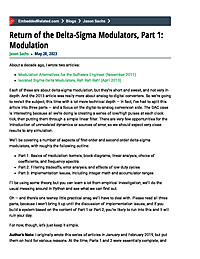
Return of the Delta-Sigma Modulators, Part 1: Modulation
About a decade ago, I wrote two articles: Modulation Alternatives for the Software Engineer (November 2011) Isolated Sigma-Delta Modulators, Rah Rah Rah! (April 2013) Each of these are about delta-sigma modulation, but they’re...

C to C++: Bridging the Gap from C Structures to Classes
In our last post, C to C++: Proven Techniques for Embedded Systems Transformation, we started to discuss the different ways that C++ can be used to write embedded software. You saw that there is no reason to be overwhelmed by trying to adopt...
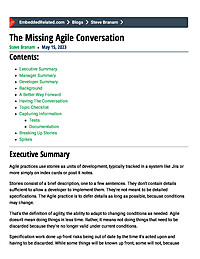
The Missing Agile Conversation
Contents: Executive Summary Manager Summary Developer Summary Background A Better Way Forward Having The Conversation Topic Checklist Capturing Information Tests Documentation Breaking Up Stories Spikes Executive...
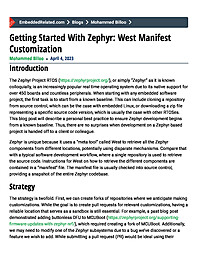
Getting Started With Zephyr: West Manifest Customization
Introduction The Zephyr Project RTOS (https://zephyrproject.org/), or simply “Zephyr” as it is known colloquially, is an increasingly popular real-time operating system due to its native support for over 450 boards and countless peripherals....

Cracking the (embedded) Coding Interview
You never forget the day you land your first job. The thrill of receiving that call from your recruiter to tell you that you bagged your dream role! The relief when you finally see the offer letter you’ve been working towards for...
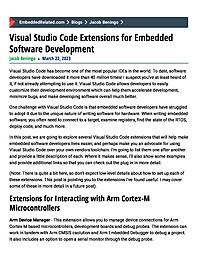
Visual Studio Code Extensions for Embedded Software Development
Visual Studio Code has become one of the most popular IDEs in the world. To date, software developers have downloaded it more than 40 million times! I suspect you’ve at least heard of it, if not already attempting to use it. Visual Studio Code...
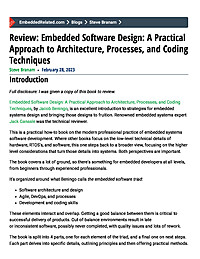
Review: Embedded Software Design: A Practical Approach to Architecture, Processes, and Coding Techniques
Introduction Full disclosure: I was given a copy of this book to review. Embedded Software Design: A Practical Approach to Architecture, Processes, and Coding Techniques, by Jacob Beningo, is an excellent introduction to strategies for...
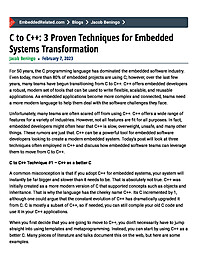
C to C++: 3 Proven Techniques for Embedded Systems Transformation
For 50 years, the C programming language has dominated the embedded software industry. Even today, more than 80% of embedded projects are using C; however, over the last few years, many teams have begun transitioning from C to C++. C++ offers...
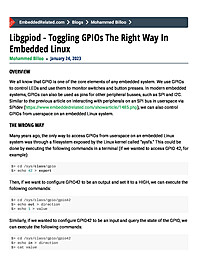
Libgpiod - Toggling GPIOs The Right Way In Embedded Linux
Overview We all know that GPIO is one of the core elements of any embedded system. We use GPIOs to control LEDs and use them to monitor switches and button presses. In modern embedded systems, GPIOs can also be used as pins for other peripheral...
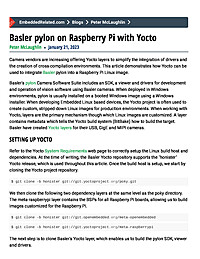
Basler pylon on Raspberry Pi with Yocto
Camera vendors are increasing offering Yocto layers to simplify the integration of drivers and the creation of cross-compilation environments. This article demonstrates how Yocto can be used to integrate Basler pylon into a Raspberry Pi Linux...
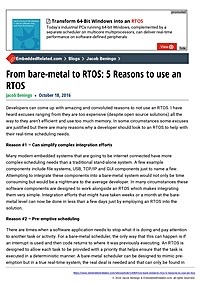
From bare-metal to RTOS: 5 Reasons to use an RTOS
Developers can come up with amazing and convoluted reasons to not use an RTOS. I have heard excuses ranging from they are too expensive (despite open source solutions) all the way to they aren’t efficient and use too much memory. In some...
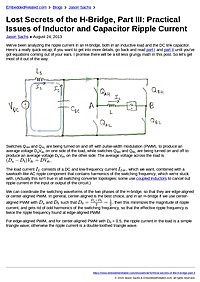
Lost Secrets of the H-Bridge, Part III: Practical Issues of Inductor and Capacitor Ripple Current
We've been analyzing the ripple current in an H-bridge, both in an inductive load and the DC link capacitor. Here's a really quick recap; if you want to get into more details, go back and read part I and part II until you've got equations coming...

VHDL tutorial - part 2 - Testbench
[quicklinks]In an earlier article I walked through the VHDL coding of a simple design. In this article I will continue the process and create a test bench module to test the earlier design. The Xilinx ISE environment makes it pretty easy to start...
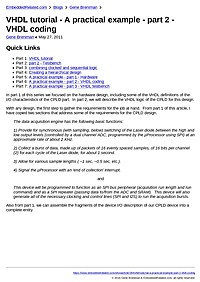
VHDL tutorial - A practical example - part 2 - VHDL coding
[quicklinks]In part 1 of this series we focused on the hardware design, including some of the VHDL definitions of the I/O characteristics of the CPLD part. In part 2, we will describe the VHDL logic of the CPLD for this design. With...

Analog-to-Digital Confusion: Pitfalls of Driving an ADC
Imagine the following scenario:You're a successful engineer (sounds nice, doesn't it!) working on a project with three or four circuit boards. More than even you can handle, so you give one of them over to your coworker Wayne to design....
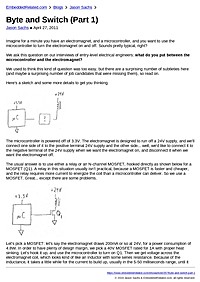
Byte and Switch (Part 1)
Imagine for a minute you have an electromagnet, and a microcontroller, and you want to use the microcontroller to turn the electromagnet on and off. Sounds pretty typical, right?We ask this question on our interviews of entry-level electrical...
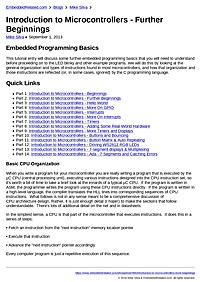
Introduction to Microcontrollers - Further Beginnings
Embedded Programming Basics This tutorial entry will discuss some further embedded programming basics that you will need to understand before proceeding on to the LED blinky and other example programs. We will do this by looking at the...
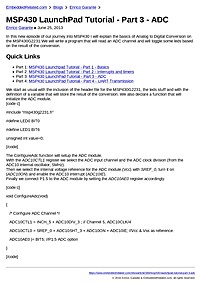
MSP430 LaunchPad Tutorial - Part 3 - ADC
In this new episode of our journey into MSP430 I will explain the basics of Analog to Digital Conversion on the MSP430G2231.We will write a program that will read an ADC channel and will toggle some leds based on the result of the...
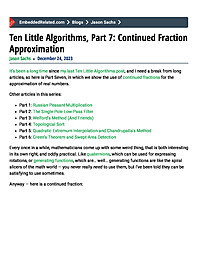
Ten Little Algorithms, Part 7: Continued Fraction Approximation
In this article we explore the use of continued fractions to approximate any particular real number, with practical applications.

More than just a pretty face - a good UI is essential
A user interface can make or break a device - determining its success in the marketplace. With careful design, the UI can make the product compelling and result in a high level of satisfaction from new and experienced users.




















